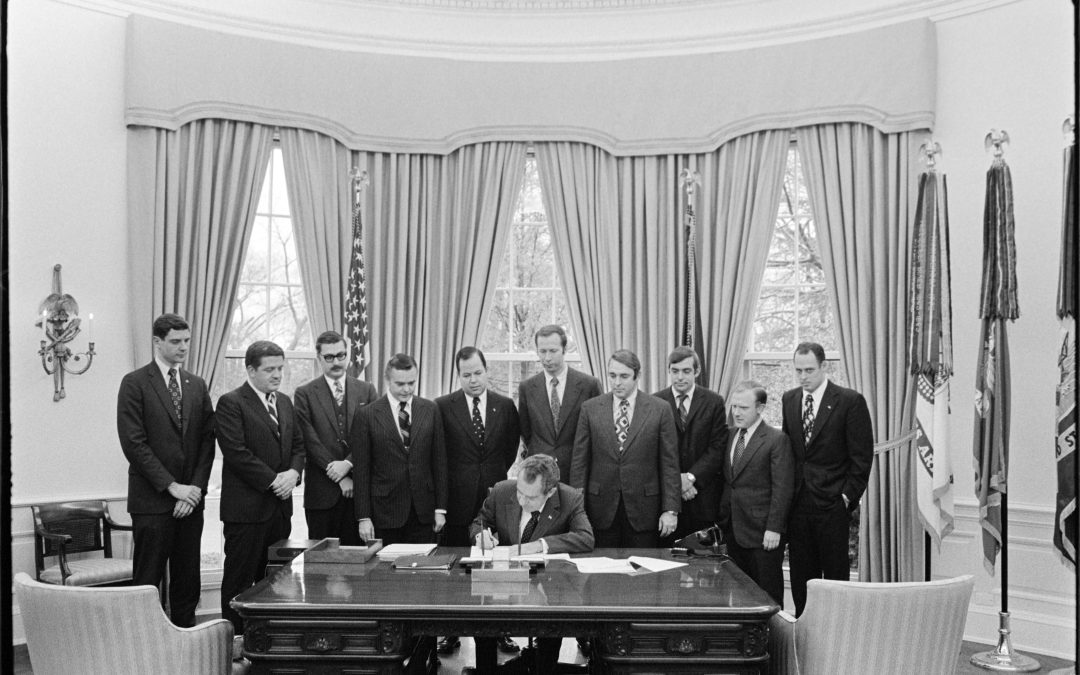President Nixon signing the 1973 State of the Union Address at his Oval Office desk while Domestic Council officials and staff stand nearby.
In a few days, you will have the chance for a live viewing of President Biden’s State of the Union address to Congress. In 1973, this was not possible because President Nixon chose to deliver his annual State of the Union message in the form of six written messages. In his first message, President Nixon begins with an explanation for delivering written reports in lieu of a single address:
This year in particular, with so many changes in Government programs under consideration–and with our very philosophy about the relationship between the individual and the State at an historic crossroads–a single, all-embracing State of the Union Message would not appear to be adequate. I have therefore decided to present my 1973 State of the Union report in the form of a series of messages during these early weeks of the 93rd Congress.
Article II, Section 3 of the U.S. Constitution states that the President “shall from time to time give to the Congress Information of the State of the Union.” In modern times, the President typically fulfills this requirement with a live broadcast annual address to both Houses of Congress. However, throughout early presidential history, a written message was standard.
According to William Cummings in an article for USA Today, Thomas Jefferson started a tradition of submitting a message to Congress in writing. This tradition lasted over one hundred years until Woodrow Wilson delivered the address in a speech on the House floor. Wilson went on to deliver two of his annual reports in writing. Other presidents to deliver at least one State of the Union as a written message in the twentieth century included: Calvin Coolidge, Herbert Hoover, Franklin D. Roosevelt, Harry Truman, Dwight Eisenhower and Jimmy Carter. (Cummings, William (2019) “This is not the first time the State of the Union wasn’t ‘on schedule’ or ‘on location” USA Today, https://www.usatoday.com/story/news/politics/onpolitics/2019/01/24/state-union-address-history/2665594002/)
President Nixon’s State of the Union Message to Congress was given in the form of six reports over the course of about six weeks, from February 2 to March 14, 1973. While he did not give a speech, he did sum up the State of the Union in one sentence by stating, “The basic state of our Union today is sound, and full of promise.”
Overview and Goals, February 2, 1973
Excerpt: “The purpose of this first message in the series is to give a concise overview of where we stand as a people today, and to outline some of the general goals that I believe we should pursue over the next year and beyond.”
Read full message: https://www.presidency.ucsb.edu/documents/state-the-union-message-the-congress-overview-and-goals
Natural Resources and the Environment, February 15, 1973
Excerpt: “Today I wish to report to the Congress on the state of our natural resources and environment. It is appropriate that this topic be first of our substantive policy discussions in the State of the Union presentation, since nowhere in our national affairs do we have more gratifying progress–nor more urgent, remaining problems.”
Read full message: https://www.presidency.ucsb.edu/documents/state-the-union-message-the-congress-natural-resources-and-the-environment
Economy, February 22, 1973
Excerpt: “The state of our Union depends fundamentally on the state of our economy. I am pleased to report that our economic prospects are very bright. For the first time in nearly 20 years, we can look forward to a period of genuine prosperity in a time of peace. We can, in fact, achieve the most bountiful prosperity that this Nation has ever known.”
Read full message: https://www.presidency.ucsb.edu/documents/state-the-union-message-the-congress-the-economy
Human Resources, March 1, 1973
Excerpt: “As we consider the subject of human resources in this fourth section of my 1973 State of the Union Message, we must not confine ourselves solely to a discussion of the year past and the year ahead. Nor can we be content to frame the choices we face in strictly governmental and programmatic terms–as though Federal money and programs were the only variables that mattered in meeting human needs.”
Read full message:
https://www.presidency.ucsb.edu/documents/state-the-union-message-the-congress-human-resources
Community Development, March 8, 1973
Excerpt: “Today, in this fifth report to the Congress on the State of the Union, I want to discuss the quality of life in our cities and towns and set forth new directions for community development in America.”
Read full message: https://www.presidency.ucsb.edu/documents/state-the-union-message-the-congress-community-development
Law Enforcement and Drug Abuse Prevention, March 14, 1973
Excerpt: “This sixth message to the Congress on the State of the Union concerns our Federal system of criminal justice. It discusses both the progress we have made in improving that system and the additional steps we must take to consolidate our accomplishments and to further our efforts to achieve a safe, just, and law-abiding society.”
Read full message: https://www.presidency.ucsb.edu/documents/state-the-union-message-the-congress-law-enforcement-and-drug-abuse-prevention

